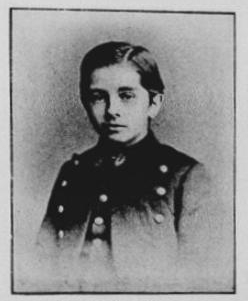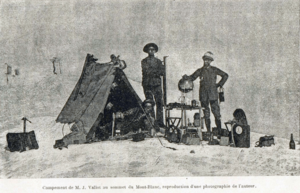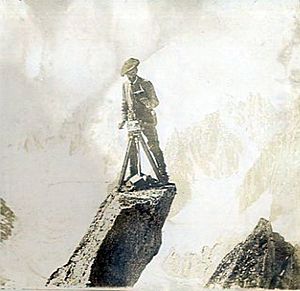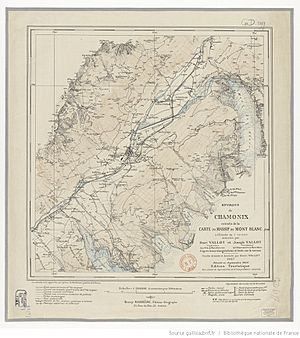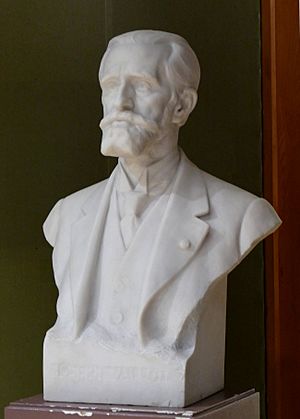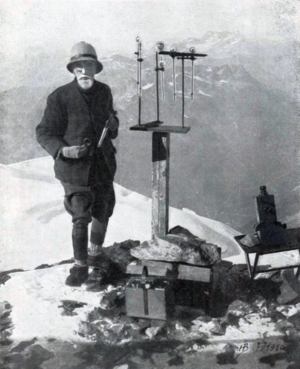Joseph Vallot facts for kids
Quick facts for kids
Joseph Vallot
|
|
|---|---|

Vallot in 1892
|
|
| Born | 16 February 1854 |
| Died | 11 April 1925 (aged 71) |
| Burial place | Père Lachaise Cemetery |
| Nationality | French |
| Known for | Scientific research on Mont Blanc; construction of observatory and mountain refuge |
| Children | 3 |
| Honours | Legion of Honour |
Joseph Vallot (born February 16, 1854 – died April 11, 1925) was a French scientist. He was an astronomer, botanist, geographer, mapmaker, and mountain climber. People often call him one of the main founders of scientific research on Mont Blanc.
Vallot is famous for his deep interest in Mont Blanc. He paid for and built a special observatory high up on the mountain. He and his wife spent many years studying and researching there, as well as at their base in Chamonix. The observatory and the nearby shelter he built are still named after him today. These buildings help mountain guides and climbers trying to reach the Mont Blanc summit.
He earned many awards for his scientific work, including France's highest honor, the Legion of Honour.
Contents
Early Life and Interests
Joseph Vallot was born on February 16, 1854, in Lodève, a town in southern France. His family was very rich from their dye and textile businesses. This wealth allowed him to pay for his many big science projects throughout his life.
Joseph Vallot went to school in Paris. He studied at the Lycée Charlemagne and then at the Sorbonne. He also studied at other famous science schools in Paris. At first, he was most interested in plants (botany) and rocks (geology). He wrote articles about plants from Africa and the Pyrenees mountains. After 1886, he wrote many articles about alpine plants for the French Alpine Club. He later became a vice-president of the Société botanique de France, a French plant society.
Vallot first visited Chamonix around 1877. He became very interested in the icy mountains of the Mont Blanc massif. In 1880, he married Gabrielle Pérou, who was also a climber and cave explorer. They had three children: André, René, and Madeleine. Madeleine became a mountain climber herself. In 1920, she set a record for women climbing Mont Blanc. Joseph and Gabrielle often wore special pith helmets when they were in the mountains.
Vallot's early work focused on plants. Between 1881 and 1889, he published many articles about different plants. He wrote about plants around Fontainebleau, plants growing in the streets of Paris, plants from Corsica, and plants from Senegal. He came to Chamonix to compare plants in the Pyrenees mountains with those in the Alps.
Vallot loved the mountains around Chamonix. He hired guides to help him climb Mont Blanc and even harder routes like the Aiguille du Dru. He would even collect alpine plants while climbing. In 1886, he climbed Mont Blanc twice. He realized that climbing the mountain every day with short stops was not good for serious science. At that time, no one knew if a person could survive a night at such a high altitude. So, Vallot decided to find out for himself.
Mont Blanc Observatories
Joseph Vallot is known as a key person in starting scientific research on Mont Blanc. He first reached the summit in 1881. This started his lifelong interest in the 4,808-metre-high (15,774 ft) mountain and its surroundings.
He moved to Chamonix. In 1887, he managed to stay three nights camped on the summit of Mont Blanc. He used porters (people who carry things) to bring 250 kilograms (550 lb) of food and equipment to the top. Most of the porters went back down. Only Vallot, two guides, and F-M Richard (who made his science tools) stayed. They faced "great physical strain and constant self-denial." They made detailed science measurements at three different heights at the same time.
His cousin, Henri Vallot, an engineer, helped him. Henri took measurements in the Chamonix valley. Other automatic readings were taken halfway up the mountain at the Grands Mulets Hut. Meanwhile, Joseph's group was camped on Mont Blanc's icy summit. After three days and nights of hard work, not feeling hungry, and having bad headaches from the altitude, Vallot and his group returned to Chamonix.
The town welcomed them like heroes. Mountain guides waved flags. The town hall was decorated with flowers. A brass band led them through the streets with cheering crowds. The mayor and other important people congratulated them. Vallot later wrote that they were "astonished and confused by such a triumph." He realized that by doing science at that height, they had also done an amazing climbing feat without knowing it.
Vallot saw that it was hard to do science on Mont Blanc without a permanent base. So, he asked his cousin Henri to design plans for a high-altitude observation station. Joseph paid for it himself. Vallot decided to build two observatories at different heights. His 'Mont Blanc Observatory' was built in Chamonix. It was a base for scientists he invited. The 'Observatoire Vallot' was placed on a rocky area below Mont Blanc's summit. This allowed them to compare measurements made in the valley with those made at high altitude.
In the summer of 1890, Vallot hired 110 porters to carry building materials. He built his observatory on the Rochers des Bosses at 4,358 metres (14,298 ft) high. Eight years later, it was moved to a better spot nearby at 4,350 metres (14,270 ft). In 1892, he also built a separate cabin for climbers. Before this, climbers had stayed in the main observatory building.
Vallot was the observatory's director for over 30 years. He and many scientists he invited made countless observations. They studied astronomy (stars), botany (plants), cartography (maps), geology (earth), glaciology (glaciers), medicine, meteorology (weather), and physiology (how bodies work). Their findings were published in seven books called Annales de l'Observatoire du Mont Blanc.
In 1891, the first recorded case of pulmonary oedema (a serious lung problem from high altitude) happened at Vallot's observatory. A Dr. Jacottet died there. In 1913, Vallot was the first to publish research showing that physical performance gets worse at higher altitudes. He used squirrels for his study.
The Observatoire Vallot was 60 square meters. It had a lab, a kitchen, and a fancy room called the 'Chinese Salon'. Vallot decorated this room with Asian items like large tapestries, Persian rugs, and a Samurai helmet. His observatory and the nearby shelter attracted scientists and adventurers, including Achille Ratti, who later became Pope Pius XI.
Vallot shared his knowledge and observatory with the French astronomer Pierre Janssen. Janssen wanted to build his own observatory on the icy summit of Mont Blanc. Vallot knew a lot about glaciers and how ice moves. He strongly advised against Janssen's plan. But the project went ahead in 1893. It only worked for a short time before the wooden building started to sink into the ice. It was finally taken apart in 1909. The wood was used as firewood in Vallot's own observatory for many years.
In 1984, Vallot’s Chinese salon was taken apart. It was put back together in the Alpine Museum in Chamonix. This was part of a plan to update the observatory for new scientific research.
Mapping the Mountains
For about thirty years, Joseph Vallot worked with his cousin Henri. Henri had a big project to survey and create a new, detailed map of the Mont Blanc massif. Joseph did the surveying and photography high up in the mountains. Henri surveyed at lower heights. Only one map was published while they were alive. This map showed the northern slopes of Mont Blanc down to Chamonix. Henri's son, Charles, published the rest of the work later. Vallot received an award from the Société de Topographie de France for his help with his cousin's work.
Other Achievements
In the 1890s, Vallot was the first person to make very detailed measurements of the ablation zone of the Mer de Glace. This is the largest glacier on the Mont Blanc massif and in France. The ablation zone is where the glacier loses ice.
In 1899, he and his cousin, Henri Vallot, officially supported a plan to build an underground railway tunnel. This tunnel would go from the town of Les Houches to just below the summit of Mont Blanc.
Awards and Honors
Joseph Vallot received many honors and awards during his life. These were for his work in mapmaking and high-altitude science, much of which he did with his wife.
In 1895, Vallot won a gold medal from the Société d'Encouragement. This was for building the Mont Blanc Observatory.
He also won the 'grand prix des sciences physiques' and the 'prix Wilde' from the French Academy of Sciences. He received the Legion of Honour. He was made a Knight of the Order of Saints Maurice and Lazarus, an officer of the Order of the Medjidie, and an officer of the Order of Saint-Charles of Monaco. Vallot was also an honorary president of the French Alpine Club.
Many places are named after him, including:
- Avenue Joseph Vallot and Lycée Joseph-Vallot in Lodève
- Rue Joseph Vallot in Chamonix
- Rue Joseph Vallot and Avenue Joseph Vallot in Nice
Later Life
From 1905, Joseph Vallot's health began to get worse because of his many long stays at high altitude. He started spending his winter months in Nice, where the weather was better for him. He was still very active there. In Nice, he built a weather station to study the region's weather. He also continued his interest in plants. According to the Alpine Museum in Chamonix, Vallot collected about 200,000 plant samples. He gave these to the Nice museum.
In 1907, Vallot worked with the filmmaker Léon Gaumont. They made a film about climbing Mont Blanc.
In September 1920, at 66 years old, Vallot made his last climb to his high-altitude observatory. He stayed there to make scientific measurements. From there, he also made his 34th and final climb to the summit of Mont Blanc.
As his health got worse, Vallot left Chamonix and moved to his home in Nice. He died there on April 11, 1925, after a long illness. He is buried at Père Lachaise Cemetery in Paris. In his will, Vallot left his observatory to the French nation. Since then, it has been used by the Paris Observatory, the French National Centre for Scientific Research (CNRS), and more recently, the Research Center for Alpine Ecosystems (CREA Mont-Blanc).
Selected Publications
- Vallot (1882) Studies on the Flora of Senegal.
- Vallot (1883) Studies on the Flora of Senegal.
- Vallot (1884) Essay on the Flora of Paris Pavements.
- Vallot (1887) Three Days on Mont Blanc: Five Ascents to the Summit.
- Vallot J (1900) Annals of the Meteorological, Physical, and Glacial Observatory of Mont Blanc. Vol 4.
- Vallot J (1905) Annals of the Meteorological, Physical, and Glacial Observatory of Mont Blanc. Vol 6.
- Vallot, H. & Vallot, J. (1907) Map of the Mont Blanc Massif.
See Also
 In Spanish: Joseph Vallot para niños
In Spanish: Joseph Vallot para niños
- Tête Rousse Glacier
- Vallot Glacier
- Venance Payot
- Legion of Honour


